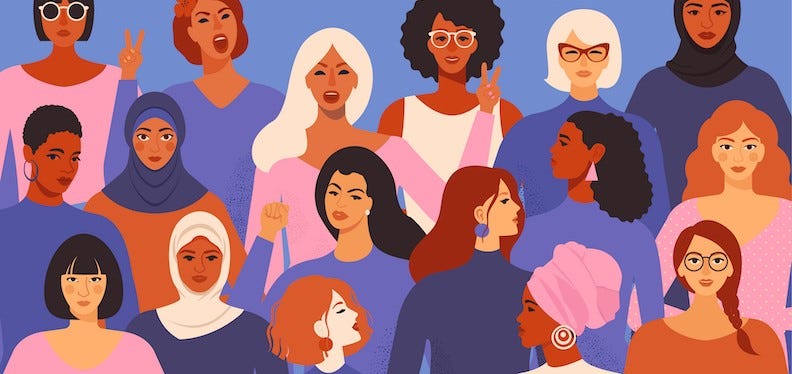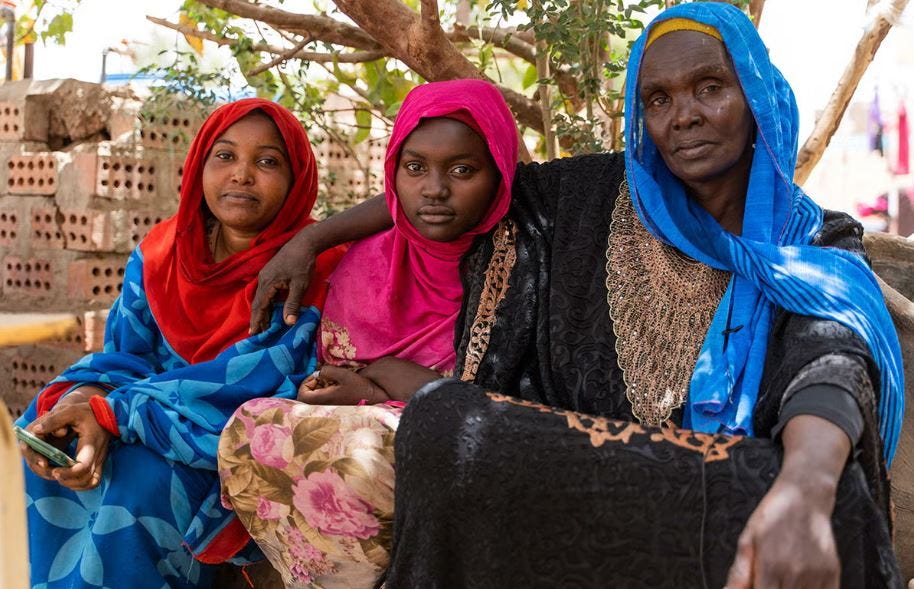Dearest Reader,
International Women’s Day (IWD) was on Saturday March 8th. I always look forward to International Women’s Day because it feels like the day that best captures my demographic: an international woman. I still love the U.S. despite all her unending hypocrisies and I whole-heartedly love my Kenyan ancestry despite our pathological obstacles. On that single day once a year, I can shout my interconnected international pride from the rooftops.
IWD is also a day to commemorate the ongoing challeneges that women face with respect to gender equality, reproductive rights, and violence or abuse against women. It’s a day that comes around once a year, during Women’s History Month (still recognized in the States, despite all attemps to the contrary) that acknowelges all woman across the world do, in fact, exist. But this year I was a bit befuddled on my beloved International Women’s Day. I found myself puzzling over how I personally felt as a woman in this particular space and time. I also mused over where we as “women” writ large stand on the world’s stage.

My mother was overjoyed when I was born. She tells the story of my birth and how much after two beautiful boys, she wanted a daughter. So when I was born, she was thrilled. My mother is an anthropologist who dedicated her life to advocacy, research and writing on women’s rights, especially African women. She has five sisters, I was raised with two brothers all by myself, but my mom always made me feel wanted and celebrated as a girl and now as a woman. It’s a gift really, I didn’t quite understand why I was born a girl in childhood, especially when your siblings are boys and don’t always include you in stuff. We definitely hung out and made great memories together; my brothers are pretty welcoming and good guys, but nevertheless, there is a line. Whereas with my mother and other women in my life, there’s no line, so long as trust and understanding is there.
But this year, the vibe of International Women’s Day—the day when I get to celebrate all the gains for women and girls plus recognize unmet challenges or crises—was off by a mile. According to the Council on Foreign Relations that tracks conflict, there are some 28 (major) ongoing geopolical conflicts worldwide, dancing between unchanging, worsening and improving. There are, in facr, 110 armed conflicts of all shapes and sizes around the globe, according to the Geneva Academy of International Humanitarian Law and Human Rights. No matter the scale, location, or players, the greatest victims of these conflicts are women and children. In Sudan, Ukraine, Democratic Republic of Congo, Syria, Palestine, Lebanon, Iraq, Afganistan, Pakistan, Haiti, or Venezuala and beyond, civilians bear the brunt of the punishment.
Looking at Sudan, for instance, the sheer scale of suffering is staggering with 25.6 million people “classified in crisis or worse” regarding food insecurity and “famine [exists] in some internally displaced people (IDP) camps [with] risk [of] further spread.” It’s been a worsening state of affairs since April 2023 when war broke out between the Sudanese Armed Forces (SAF) and the Rapid Support Forces (RSF). Both armed forces were on the same side after a long simmering 2019 civilian uprising that toppled the thirty-year reign of former President Omar al-Bashir. Al-Bashir is wanted from war crimes inlcluding genocide by the International Criminal Court (ICC), but is currently succumbing to old age in a military hospital north of Khartoum.
After the fall of al-Bashir, the Transitional Sovereignty Council was formed in August 2019, comprised of equal parts military officers and civilians. The Council ended up with the SAF as Chair and RSF as vice-chair with 21 months of military rule followed by 18 months of civillian leadership to presumably elect a new president and lead a new more democratic government. By October 2021 the SAF dissolved the council with the support of RSF against civilian wishes. By April 2023 the relationship between SAF & RSF soured, as well, leading to civil war.
The RSF is allegedly financed by the United Arab Emirates (UAE) and the SAF is purpodedly backed by Egypt and seen as the better democratic alternative by the United States and Saudi Arabia. At the end of the day, what is the fight between the SAF and RSF about? It’s about domination over land, people and resources of which Sudan has an abundance. Without civilian governence in the way, ‘to the victor go the spoils,’ I suppose. Some argue the U.S. was distracted between 2019 and 2023 and didn’t de-escalate the situation before it metastasized into what former U.S. Secretary of State Antony Blinken deamed a "genocide" on the civilian population by RSF—a term that some also attribute to the destruction of Gaza according to the United Nations, the Internatial Court of Justce (ICJ), Human Rights Watch and Amnesty International.

Just a week ago on March 6th the Associate Press reported that Sudan filed a case with the ICJ against the UAE accusing them of financing a genocide in Sudan through the RSF. As of November 2024 some 61,000 Sudanse have died as a result of this war, with at least 26,000 deaths from direct violence and the rest by preventable diseases or starvation. Gaza’s official death toll is about the same, but there is no benefit in minizing either conflict. I’m sure the true death toll for both regions, once the guns go silent, are far worse. Tragically some 600,000 Sudanese people are ‘on the brink of starvation,’ 11 million people are displaced and there are widespread reports of sexual violence, exploitaion and rape of women and girls from pre-teen years old to 75. Some women have taken their own lives as a result of the sexual violence they suffered and there is growing fear around claims of women killing themselves before or after an assault.
As noted by the Carnegie Endowment for International Peace, Sudan has been governed by militarty politics since 1956 with the exception of 10 years of elected civilian rule. Though the SAF are no angels, it appears the RSF are on a rampage of wonton destruction well beyond the SAF. It stands to reason that the Sudanese are in uncharted waters, anxious for relief. Sound familiar? It’s not to precisely compare experiences or contexts as much as to witness our common humanity. However Sudan decides to govern—hopefully by civilan democrtic rule—women and children remain the most imperiled by war. Imagine, at least 160,000 women are pregnant amidst Sudan’s war as reported in September 2024 by UN Women.
Sudan is a unique nation worthy of respect with a univisally redundant pattern of men fighting over resources on the basis of ethnicity, race, religion, class or just plain greed. The Georgetown Institute for Peace, Women and Security released a report in January on conflicts to watch. They asserted that, “women’s rights are increasingly their own battlefield, with many countries imposing greater restrictions on women’s hard won freedoms. If current treds persist, gender equality won’t be achieved until the 22nd century.” The institute distingusied this current moment in a meaningful way: today is the most globally contentious period since 1946 when they started tracking state-based hostilities. They also ackowledge a “staggering” number of instances of sexual violence worldwide, against everybody really, but esepcially women and girls. Accoding to a November report from UN Women, “An estimated 736 million women—almost one in three—have been subjected to physical and/or sexual intimate partner violence, non-partner sexual violence, or both at least once in their life (30 per cent of women aged 15 and older).”And that figure doesn’t even inlcude instances of sexual harrasment.

In addition to my frustration and grief over the state of the world for women on International Women’s day this past March 8th, I recognized something promising. I noticed more purposeful statements from women interpersonally and online for International Women’s Day. Perhaps amidst of this suffering, women—especially in the West—are coming to terms with the common themes of subjugation we endure across borders. To the women and girls around the world toiling in their broken environments (including the US of A, mind you) I pray we attain or maintain safety, consistent treatment and prolonged paths towards peace and security.
The truth of the matter is, as I have communicated repeatedly in my writing, ‘there before the grace of [insert God figure here] go I’—meaning we’re not as different from one another as we too often assume. A few things go sideways and overall freedom or security can fracture—anywhere. Also our daily priorties and dreams often mirror one another. Everyone wants love, security, growth, purpose. But when a government is no longer representative of civil society and/or compromised by private intersts to the detriment of civil society, rights and freedoms can take a major tumble down an authoritian rabbit hole. I suppose that’s why it matters to take a moment and look around…checking in on the safety of women and girls as a daily indicator of our collective security. Ideally democratic rights are attained and retained, but sometimes things unfortunately backslide. It’s always preferable to retain and build upon your rights than try to get them back, so God speed to us all on our way.
With Love During End Times,
Agunda




